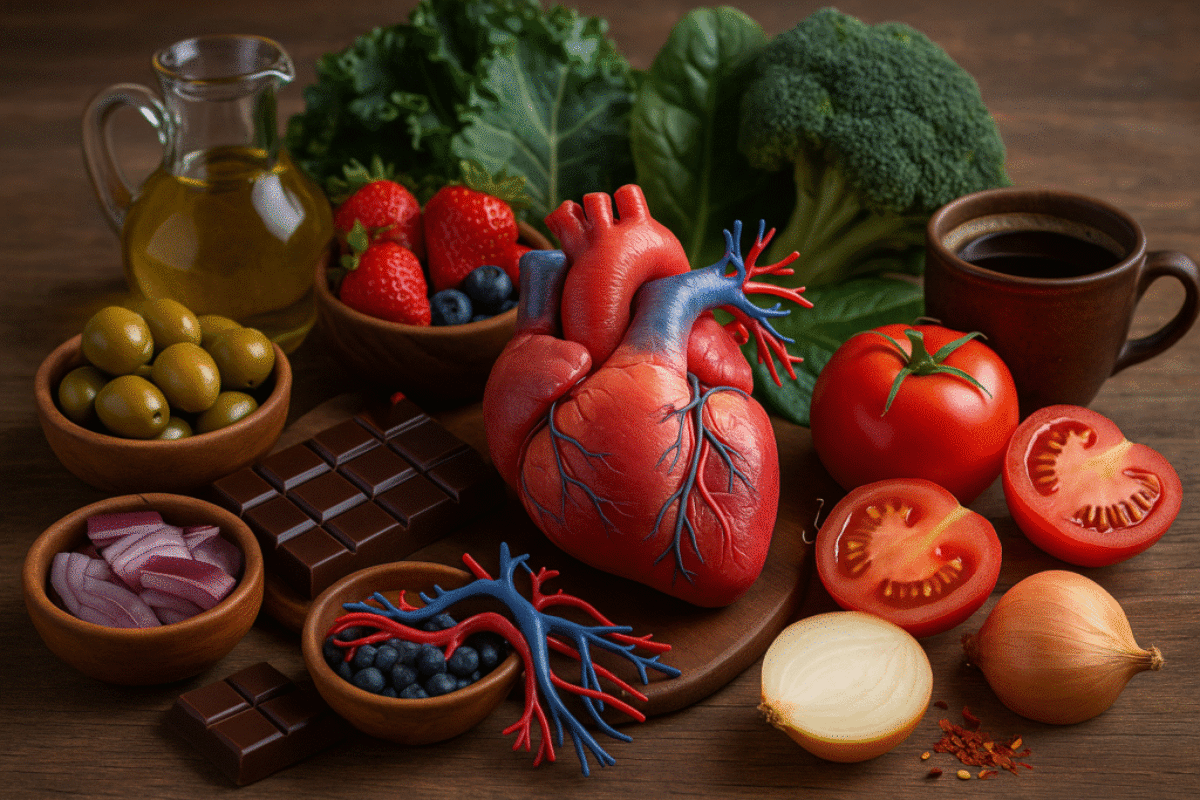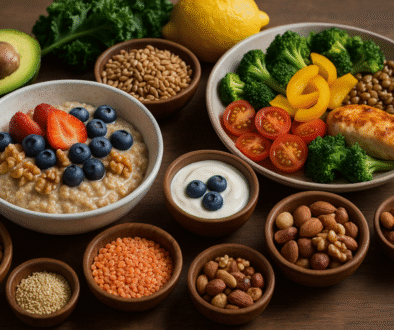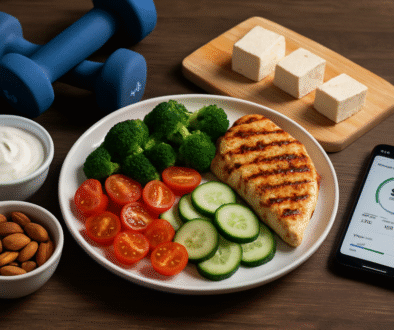Top 10 Blood Vessel Health Foods + Diet Hacks for Longevity
Why Blood Vessel Health Foods Matter from Day One
When it comes to blood vessel health foods, what you eat literally shapes the 60,000-mile network that delivers oxygen and nutrients to every organ. Choosing the right “roads”—from leafy greens to olive oil—keeps your arteries supple, fights inflammation, and protects against age-related diseases. Whether you’re aiming to support cognitive function, prevent heart disease, or slow skin aging, integrating these vascular health foods is your first line of defense.
Top 10 Blood Vessel Health Foods
Leafy Greens & Brassicas
Why: Loaded with fiber, polyphenols, and sulforaphane to reduce oxidative stress.
How: These blood vessel health foods feed gut bacteria that produce anti-inflammatory short-chain fatty acids.
Recipe Tip: Sauté kale and broccoli with garlic, lemon, and a splash of extra-virgin olive oil.
Extra-Virgin Olive Oil & Olives
Why: Rich in hydroxytyrosol, which shields endothelial cells from damage.
How: Supports vessel repair and keeps your arteries flexible.
Pro Tip: Single-varietal oils (Koroneiki, Picual) have the highest polyphenol levels.
Berries
Why: Anthocyanins and ellagic acid in strawberries and blueberries bolster capillary strength.
How: These berries are prime blood vessel health foods for lowering blood pressure and cognitive protection.
Tomatoes
Why: Lycopene-rich tomatoes fight free radicals and support vessel elasticity.
How: Roast cherry tomatoes with herbs for a lycopene-packed side dish.
Onions
Why: Quercetin concentrates in onion skins to boost nitric oxide and circulation.
How: Caramelize red onions for salads or whole-grain wraps.
Green Tea & Coffee
Why: Catechins and chlorogenic acid lower oxidative stress and activate brown fat.
How: Enjoy 2–3 cups daily—another simple way to leverage blood vessel health foods.
Dark Chocolate (≥80% Cocoa)
Why: Flavanols improve endothelial function and blood flow.
How: A small square after dinner delivers a cardiovascular boost.
Fatty Fish & Omega-3 Sources
Why: EPA and DHA in salmon and sardines reduce vessel inflammation.
How: Aim for 2 servings per week to reinforce your vascular walls.
Nuts & Seeds
Why: Almonds, walnuts, flax, and chia provide fiber, magnesium, and plant-based omega-3s.
How: Snack on a handful to stabilize blood sugar and lower LDL cholesterol.
Spices & Herbs
Why: Turmeric (curcumin), ginger, and chili flakes (capsaicin) promote circulation.
How: Stir them into soups, smoothies, or marinades.
Good vs. Bad Fats: A Vascular Perspective
Good Fats: Monounsaturated (olive oil, avocados) and polyunsaturated (omega-3s) support vessel integrity and reduce inflammation.
Bad Fats: Trans fats and excessive omega-6 from processed oils stiffen arteries and trigger oxidative damage.
Swap Suggestion: Replace margarine with extra-virgin olive oil and fried fish with wild-caught salmon.
Activate Brown Fat for Extra Vascular Benefits
Brown adipose tissue (BAT) burns harmful white fat, improving insulin sensitivity and circulation.
Cold Exposure: Brief cold showers or cool-weather walks.
Diet Triggers: Green tea, coffee, chili peppers, and cinnamon.
Omega-3s: Fatty fish primes BAT activity for better blood vessel health foods synergy.
Everyday Swaps for Lasting Impact
Ditch Sugary Drinks: Opt for green tea, herbal infusions, or sparkling water with lemon (instead of soda).
Avoid Ultra-Processed Snacks: Choose fruit with nut butter or air-popped popcorn.
Use Fresh Oils: Steer clear of reused cooking oil; stick to olive or avocado oil.
Flavor Smart: Season with garlic, herbs, and citrus zest instead of excess salt.
Practical Tips to Keep Vessels Vibrant
Prioritize Fiber: Whole grains, beans, and lentils feed beneficial microbes.
Read Labels: Look for “100% whole grain” and avoid hydrogenated oils.
Cook Mindfully: Bake, steam, or roast instead of deep-frying.
Stay Hydrated: Aim for 8–10 cups of water daily; include mineral-rich options like coconut water.
Authoritative Resources
For more on vascular health and diet:
American Heart Association’s guide to heart-healthy eating:
https://www.heart.org/en/healthy-living/healthy-eatingMayo Clinic’s overview of cardiovascular benefits of fruits and vegetables:
https://www.mayoclinic.org/diseases-conditions/heart-disease/in-depth/heart-disease-prevention/art-20046502Conclusion & Next Steps
Incorporate just one new blood vessel health foods item each week—be it a handful of berries or a drizzle of extra-virgin olive oil—and watch cumulative benefits unfold. Over time, these small dietary shifts build resilience against cognitive decline, heart disease, and metabolic dysfunction.
“Food is medicine. Your body’s repair tools are already inside you—you just need to activate them.” — Dr. William Li



